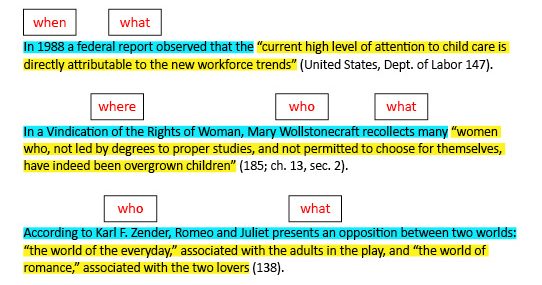Note: This post relates to content in the eighth edition of the MLA Handbook. For up-to-date guidance, see the ninth edition of the MLA Handbook.
Lesson Plan
Grade Levels
9–12
Objective
Students will write sentences that incorporate quotations to provide readers with the context of the original source and the connection to the essay’s main idea.
Total Estimated Class Time
45 minutes
Additional Outcome
Students will think critically about how their source material connects with the main idea of their essays and develop note cards that will help them start a draft.
Course Work or Assignment Underway
Students have completed an annotated bibliography and are preparing to write an essay supported by evidence from researched and cited sources.
Work Completed before Class
Students should have copies or printouts of their sources with some parts highlighted for potential use in their essays. Previous class sessions will have introduced students to searching for and evaluating sources and creating an MLA-style works-cited list for their annotated bibliographies.
Sequence of Classroom Activities
- Pass out copies of sample research paper, and ask students to highlight quotations.
- Ask students to notice how rarely a quotation stands alone as its own sentence. Often, the quotation occurs at the end of the sentence and sometimes at the beginning of the sentence. Ask students to use a different color highlighter to highlight the words in the sentence before or after the quotation. Then ask them where in the sentence quotations most often appear: the beginning, the middle, or the end.
- Introduce students to the 5W and 1H questions (also known as the journalistic questions): who? what? when? where? why? how? Note that while writers might not provide answers to all those questions in the introduction to the quotation, they might answer some of them to provide necessary context for the quotation. Ask students to label the information provided before the quotation with who, what, when, where, why, or how to show what type of context is being provided. (Below, I have provided some examples, taken from the MLA Handbook, 8th ed.)
- Discuss why it’s important for writers to provide the context for a quotation.
- It can add credibility to the quotation because you show who originated it and what that person’s expertise is.
- It can add credibility to the quotation because by showing when it was written, you show that it is a timely source.
- It can help your readers understand the quotation better because you explain your source’s purpose (why it was written).
- Give students copies of the blank Note-Taking Template. Use a gradual-release-of-responsibility protocol (such as show-you, guide-you, watch-you, let-you) to have students complete sections 1 and 2 of the template for each of their quotations.
- Show you: Use the sample completed template in the Note-Taking Template to show how section 1 provides some context (who, what, when, where, why, how) and section 2 provides the paraphrase.
- Guide you: Display a blank template for the whole class to see. Ask a student to volunteer a quotation from any articles brought to class. Write that quotation in section 2 of the template. Ask that student the who, what, when, where, why, how of the quotations. As a class, come up with a way to incorporate the most important part of that context in section 1 of the template.
- Watch you: Divide students into small groups. Ask them to work with each other to produce one note-taking card for each student in the group. Circulate around the room to help with specific issues and to assess competence.
- Let you: Once student have achieved competence in a small group, you can assign the rest of the cards for independent practice.
5W and 1H Example

Alternative Approaches
A lesson on citing the material (section 3 of the template) may be done after or before this lesson. A lesson on explaining how the material relates to the student’s topic (section 4 of the template) may be done after or before this lesson. When students have completed all sections of the Note-Taking Template, they can print out the document and cut each into a separate “note card” to work on organizing and then drafting their essays.
To see how you can adapt these activities for undergraduates, see the lesson plan for college students.
Lesson Materials
Copies of a sample research paper or of a body paragraph from a sample research paper
Highlighters of different colors
1 Comment
Dorota 23 November 2023 AT 05:11 PM
A good lesson plan, thanks
Join the Conversation
We invite you to comment on this post and exchange ideas with other site visitors. Comments are moderated and subject to terms of service.
If you have a question for the MLA's editors, submit it to Ask the MLA!